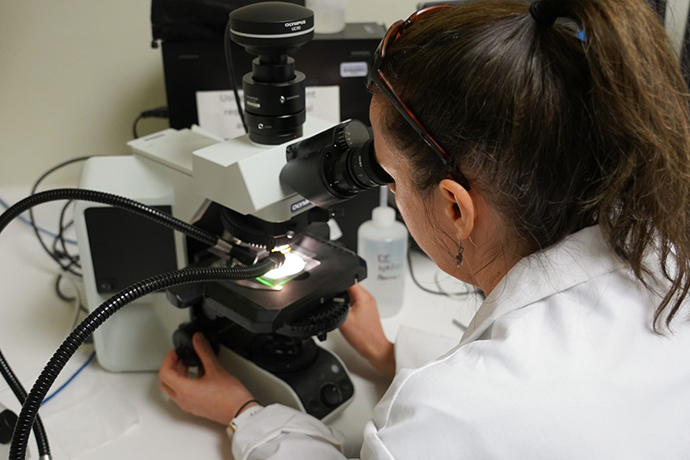Tons of Microplastic Rains into Western U.S. Protected Lands Annually

Microplastic particles and fibers spiral through the Earth system, accumulating even in protected wilderness areas and national parks in the western U.S.
Assistant Professor Janice Brahney didn’t go looking for minuscule plastic particles in some of the West’s best-known and “pristine” places, but that’s what she found.
Brahney, a biogeochemist in Utah State University’s Department of Watershed Sciences, was pilot testing new equipment she designed to collect samples of particles deposited by wind and precipitation by gathering samples over 14 months in 11 national parks and wilderness areas in the western U.S.
She was prepared to identify minerals and organic matter among the millions of dust particles, but when samples were under the microscope she found an array of brightly colored beads and shards. Brahney and her colleagues identified the composition of the plastics and polymers to identify sources of plastic emitted into the atmosphere and track its movement and fallout.
“We were shocked at the estimated deposition rates and kept trying to figure out where our calculations went wrong,” Brahney said. “We then confirmed through 32 different particle scans that roughly 4% of the atmospheric particles analyzed from these remote locations were synthetic polymers.”
That surprising finding—and the accompanying questions it raises about the possible impacts of microplastics in ecosystems and in the air we breathe—captured the attention of science writers worldwide when Brahney and her co-authors published their findings in the journal Science in mid-June. In the paper, researchers point out that their estimates of the volume of plastic particulates carried by air masses and deposited miles from their sources are conservative because clear and white particles did not meet the experiment’s standard for being counted, meaning fragments of clear plastics like water bottles were not included.
The world produced 348 million metric tons of plastic in 2017 and while it’s resilience and longevity make plastics particularly useful in everyday life, these same properties lead to progressive fragmentation instead of degradation in the environment. These “microplastics” are known to accumulate in wastewaters, rivers, and ultimately the worlds’ oceans, and as Brahney’s team shows, they also accumulate in the atmosphere.

“Several studies have attempted to quantify the global plastic cycle but were unaware of the atmospheric limb,” Brahney said. “Our data show the plastic cycle is reminiscent of the global water cycle, having atmospheric, oceanic, and terrestrial lifetimes.”
The study, supported by the Utah Agricultural Experiment Station, National Science Foundation and an agreement with the USDA Forest Service, examined the source and life history of both wet (rain) and dry microplastic deposition. Cities and population centers were found to serve as the initial source of plastics associated with wet deposition, but secondary sources included the redistribution of microplastics re-entrained from soils or surface waters. In contrast, dry deposition of plastics showed indicators of long-range transport and was associated with large-scale atmospheric patterns. This suggests that microplastics are small enough to be entrained in the atmosphere for cross-continental transport.
The team’s field and lab personnel used sterile sampling equipment, personal protection, and protocols to minimize particle contamination. Most of the plastics deposited in both wet and dry samples were microfibers sourced from both clothing and industrial materials. Approximately 30% of the particles were brightly colored microbeads, but not those commonly associated with personal care products. These microbeads were acrylic and likely derived from industrial paints and coatings. Other particles were fragments of larger pieces of plastic. The report notes, “This result, combined with the size distribution of identified plastics, and the relationship to global-scale climate patterns, suggest that plastic emission sources have extended well beyond our population centers and, through their longevity, spiral through the Earth system.”


Results from this study highlight the source, transport, and fate of plastics on Earth surfaces as well as the contamination of U.S. protected environments. Examining weekly wet and monthly dry samples from 11 sites—including the High Uintas Wilderness, Craters of the Moon National Monument, and Grand Canyon, Bryce Canyon, Rocky Mountain, and Joshua Tree national parks— allowed the authors to estimate that more than 1,000 tons of microplastics are deposited onto protected lands in the western U.S. each year, equivalent to more than 123 million plastic water bottles.
Brahney said seeing plastics in the samples came at a “wonderfully serendipitous moment” of having just the right people available to contribute their skills and knowledge to aspects of the project that were not her expertise.
Among the study’s co-authors are Brahney’s former lab technician, Eric Heim, and Margaret Hallerud, an undergraduate student researcher. Hallerud wrote the computer code to back-link the atmospheric trajectory models to population data and assisted in interpreting climate data. She will start graduate school at the University of Maine in the fall and received a National Science Foundation Graduate Fellowship. Heim was the technician in Brahney’s lab who ran Hallerud’s models and generated the spatial data. Heim is currently a technician at the University of Colorado Boulder. The paper’s other co-authors are Maura Hahnenberger in the Geosciences Department at Salt Lake Community College and Suja Sukumaran in the Material Sciences Division of Thermo Fisher Scientific.
“This ubiquity of microplastics in the atmosphere and the subsequent deposition to remote terrestrial and aquatic environments raise widespread ecological and societal concerns,” Brahney said. “Identifying the key mechanisms of plastic emission to the atmosphere is a first step in developing global-scale solutions.”
Media outlets around the world talking about micorplastics
Science Magazine: Plastic dust is blowing into U.S. national parks
Science Daily: More than 1000 tons of plastic rains into Western US protected lands annually
EarthSky.org: Plastic rain: More than 1,000 tons of microplastic rain onto western U.S.
The Washington Post: Plastic pollution, even in pristine places
Design News: It's No Longer Raining Cats and Dogs--It's Raining Plastic

